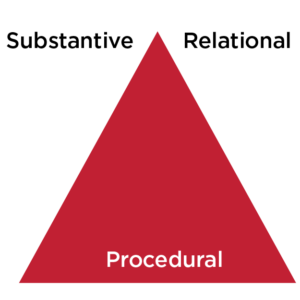
By: Harry Webne-Behrman
Among the skills we develop in the Center for Professional & Executive Development’s Project Leadership Communication course are those skills necessary to manage conflict effectively.
Specifically, we explore and practice scenarios in which project managers and other team leaders must facilitate difficult, conflictive conversations through a collaborative process that allows group members to address core interests and concerns that inhibit their working relationships. These may arise through challenges meeting project deadlines, disagreements over resource allocations, differences in work and communication styles, unresolved previous issues that continue to fester, or natural “turf” issues that arise within large, bureaucratic, profit-driven organizations.
Where Does Conflict Come From?
I want to emphasize here that conflicts arise naturally within teams – they aren’t caused by “bad people” who want to be “difficult employees.” Certainly, there are such individuals and they should be managed clearly and directly in accordance with performance expectations. But the vast majority of team members are simply trying to do their best work and perceive threats to their abilities to do so, hence, the conflicts that arise. These conflicts present a unique challenge – and opportunity – for project managers and other leaders.
Conflicts arise naturally within teams – they aren’t caused by “bad people” who want to be “difficult employees.”
– Harry Webne-Behrman
There are three types of needs present to be negotiated: Substantive needs, procedural needs, and relational needs.
Substantive needs relate to the “stuff” of the conflict, and often reflect our initial definition of what needs to be addressed. Procedural needs are reflected in people’s sense of being engaged in an inclusive, fair process where the rules or processes for addressing the issues are transparent and understood. Finally, there are also relational needs, reflected by words like trust, respect, honesty, safety, and integrity.

While many project managers tend to focus on the substantive issues in conflict – for which there may be technical solutions – they often ignore the procedural and relational needs that tend to be highly emotional and complex. This is done at our own peril, for these needs are usually the keys to transforming conflict into a learning and growth opportunity for the team, one that can result in significant performance improvements and sustained solutions.
A Four-Step Process for Facilitating or Mediating a Conflict Conversation
Step 1: Center Yourself
Chances are good that you are feeling anxious internally, perhaps surprised at the expression of conflict before you. You may also be experiencing a crisis of confidence, wondering whether you can respond effectively and de-escalate the tension and threat in the group. Take a moment to relax, get centered, breathe, and prepare to listen.
Step 2: Inquire with Genuine Curiosity
What is happening here? Listen fully to the disputants. What are their initial positions? More importantly, what are their underlying needs, concerns, and interests? Take your time to reveal these underlying issues for all to understand. This is a start, not a settlement, and it requires patience.
Step 3: Build Possible Solutions
Use good problem-solving skills and tools to patiently take one issue at a time, building prototype agreements to test with the disputing parties. You may need to shift approaches in light of the needs of the group, its energy, and the “ripeness” of various issues. Make sure you navigate impasses with respect, that you’re utilizing BATNA (which stands for Best Alternative to a Negotiated Agreement which describes what will happen if agreement cannot be reached), and are understanding the criteria that the parties are applying to these issues. Keep returning to the underlying interests (hopes, needs, concerns), for these are the true negotiation motivators and parameters.
Step 4: Build Agreements That Align with Broader Goals
Often, people involved in a conflict will settle for a compromise that reduces the tension but doesn’t really address the deeper issues. By patiently exploring how emerging agreements fit into the broader context and goals of the group, we can reduce the likelihood that only “symbolic” agreements result. Use the Hallmarks of Effective Agreements* as a guide, but also use your understandings of the group culture and goals to ask important, perhaps uncomfortable, questions.
Hallmarks include fairness, balance, specificity, action orientation, self-enforcement, and future-oriented considerations in framing effective Agreements. We discuss this in the PLC course.
Conflict in teams should be viewed as normal occurrences within our workspaces and processes. As resources are stretched and relationships become ever more transactional, opportunities to address these conflicts – and their potential costs to our companies – can be easily set aside. But if project managers and other leaders can address such disputes in a timely and effective manner, the dividends of such efforts can be profoundly important and satisfying, resulting in improved employee retention, engagement, and productivity.
About the Instructor: Harry Webne-Behrman

Harry Webne-Behrman has served as a facilitator, consultant, educator, and mediator for over 35 years. Along with his wife, Lisa Webne-Behrman, he served as Senior Partner of Collaborative Initiative, Inc., a private consulting and mediation firm based in Madison, Wisconsin from 1991-2017. Harry has worked with hundreds of businesses, schools, community groups and public agencies, facilitating large-scale deliberation and engagement processes, as well as mediating interpersonal disputes, and he maintains tremendous enthusiasm about the importance of learning to work collaboratively to build positive work environments.